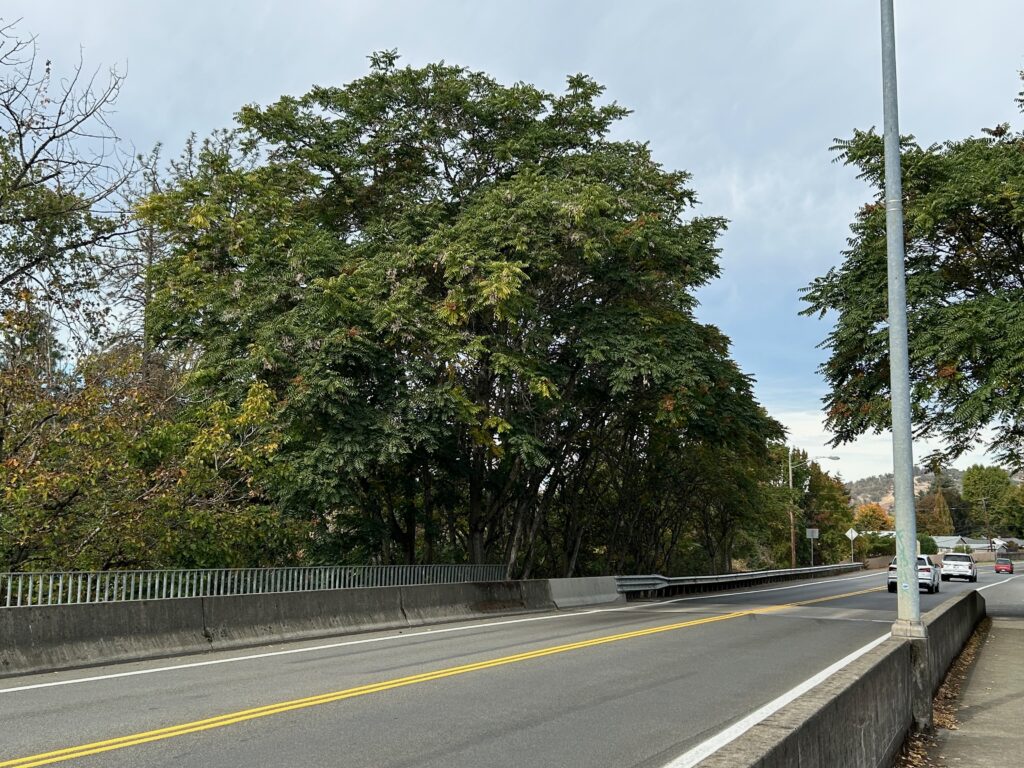



Published in News-Review October 25, 2024
By: Bonnie Courter
Question: I’ve noticed these tall trees growing along the bridge across from Stewart Park. They have interesting seed pods. Can you tell me what they are and more about them?
Answer: The trees you describe are called tree-of-heaven, Ailanthus altissima, and are unfortunately not so “heavenly”, but an invasive, noxious weed. You see them in multiple places around town such as at the top of Winchester Street.
Also known as ailanthus, the tree is native to China and Taiwan. Introduced into the Philadelphia area in the late 1700’s, it was later brought to the West Coast in the 1850’s. Initially valued as a unique, fast-growing shade tree that tolerates poor soils and air quality, by the early 1900’s it had worn out its welcome due to its invasive properties and foul odor.
Tree-of-heaven is a deciduous tree which forms thickets that outcompete native plants. It also leaches allelochemicals into the soil which inhibit the growth of other neighboring plants. This tree can grow up to 100 feet tall as a single tree (the Latin name literally means “tallest sky tree”), or it can grow in groups or thickets of many stems. It’s shallow but extensive root system can produce multiple shoots, popping up far from the trunk of the established tree up to 50 feet, and has been known to even grow through concrete walls and break up home foundations! Obviously, you don’t want this tree near your house!
It’s leaves are alternate and pinnately compound with leaflets arranged along a single stem, a single leaf growing 1-3 feet long. The bark is smooth and gray, but with age takes on the appearance of rough cantaloupe skin. Tree-of-heaven produces vegetatively by root and stump sprouts as well as by seed. Male and female flowers occur on separate trees, with the female flowers developing into clusters of samara, each having a single seed in the middle of a papery, slightly twisted wing. One mature female tree can produce over 300,000 seeds annually, so you can see how invasive this tree can become!
Besides being invasive and crowding out native plants, the parts of the tree may cause skin irritation and rashes to people who handle them, so be sure to wear gloves and protective clothing. Their flowers also produce a very high volume of pollen that can be a moderate source of allergies for some people.
The proliferation of tree-of-heaven also causes a lot of concern for farmers as it is the preferred host for the spotted lanternfly. This invasive and destructive insect from Asia is a new emerging pest which can do some serious damage to important agricultural crops including grapes, fruit trees, hops and ornamentals. Nymphs and adults suck the sap from stems, trunks, and leaves, and also secrete large amounts of honeydew which invites pathogens such as sooty mold. So far, the spotted lanternfly has only been found in the northeastern United States, but could easily come in through any number of cargo transports. Should the spotted lanternfly succeed in invading the Pacific Northwest, it will likely infest stands of tree-of-heaven first – thus the importance of control and eradication methods to suppress the spread of tree-of-heaven.
You probably guessed that this is a difficult task. Hand-pulling of young seedlings before they can grow their extensive root systems can be effective as long as the soil is moist and the entire root system can be removed. Mechanical methods like cutting or mowing will only cause the tree to respond vigorously, producing lots of stump sprouts and suckers.
Systemic herbicides should target the roots and be applied July to October, which is when the tree is moving carbohydrates to the roots. Following this treatment, you will need to monitor the site for any signs of regrowth and repeat the application if necessary. Herbicides like dicamba, glyphosate, and triclopyr can be applied to foliage, bark or stem cuts. For dense thickets of trees, use a foliar application initially to target the low growth, then follow up with a bark or “hack-and-squirt” application on the remaining larger stems. The hack-and-squirt method uses a concentrated herbicide solution applied to downward-angled cuts that are spaced evenly around the stem. This method is highly selective, allowing the herbicide to move to the roots.
Persistence is the key to eliminating well-established stands of tree-of-heaven as it requires repeated efforts and monitoring. If left alone, tree-of-heaven will dominate a landscape, so it’s important to set realistic management goals which include a multi-year approach of control.
For more information on this invasive tree and the spotted lanternfly, check out the Washington State Noxious Weed Control Board’s website at https://www.nwcb.wa.gov/weeds/tree-of-heaven.
Do you have a gardening or insect question? Contact the Douglas County Master Gardeners at douglasmg@oregonstate.edu or 541-672-4461 or visit 1134 SE Douglas Ave., Roseburg. Douglas County Master Gardeners are trained volunteers who help the OSU Extension Service serve the people of Douglas County.


